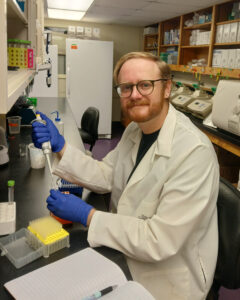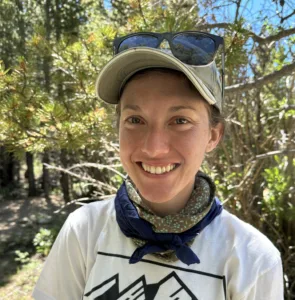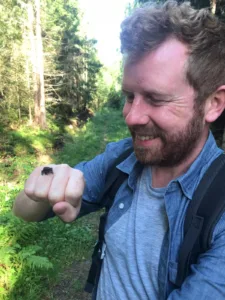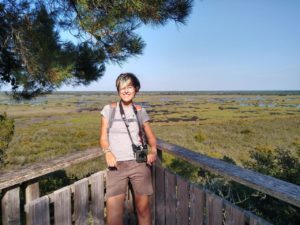ESEB and the Journal of Evolutionary Biology (JEB) award an annual prize for the best graduate papers published in the journal in that calendar year. The award is named after Stephen Stearns, who played a major role in establishing both JEB and ESEB (article).
The Stearns Graduate Student Prize is aimed at recognising outstanding graduate (Masters or PhD) research. While previously awarded to a single winner, since 2022 the JEB editorial board selects up to three joint awardees each year. This change recognises the fact that research excellence comes in many facets, ranging from the innovative nature of the questions addressed, over the technical challenges in performing the research to the scientific and societal impact of the results.
The award includes an invitation to attend the ESEB Congress (registration fee covered), where awardees present their work in a dedicated Stearns Prize symposium.
Information
Eligibility
The Stearns Prize recognises the outstanding contribution of graduate students to research published in JEB. Graduate students are eligible for the prize if they led both the research described in the article and the writing of the manuscript itself (supervisors will be asked to confirm this before awards are made). Reflecting their role, we would then also usually expect the student to be the lead (first) author. We expect papers to be submitted within two years of completing the project.
Nomination
Student-led articles that are eligible for the Stearns Prize are identified at the point of submission through a question “Was this study led by a graduate student?” in the ScholarOne form. Any manuscript for which the corresponding author answers “Yes” and identifies the student among the authors will, if accepted, be automatically considered for the Stearns Prize in the year of its publication. Self-nomination is encouraged, where the graduate student leading the study is also the submitting and corresponding author.
Selection criteria
All papers published in JEB that were entered at the point of submission as above are considered for the Stearns Prize. Editors will be asked to shortlist articles from the student-led papers they handled based on the following criteria:
- addresses an innovative research question or approaches the question in an innovative way
- contains technically challenging work
- displays a particularly robust approach to answering the research question
- demonstrates commitment to Open Science through the quality of the archived material accompanying the article (e.g. detail of readme files, organisation, presence of code) that maximises the potential for reusability and reproducibility of the research.
Shortlisted papers are then ranked using the same criteria as above by a panel of editorial board members, who have no conflicts of interest and who did not handle the papers, to minimise bias towards a particular field. The panel will be instructed to be aware of potential biases in their evaluation i.e. gender, nationality, geographic location. The top papers will be awarded the Stearns Prize for that calendar year.
2024 Winners
Théo Bodineau

This research paper was driven by the need to better understand relative contributions of breeding dates and thermal conditions during gestation on fitness of females and their offspring in viviparous reptiles. I am honoured to receive a Stearns Prize for this research which was conducted as part of my PhD at the Institute of Ecology and Environmental Sciences of Paris, Sorbonne University (France), in collaboration with my PhD advisors Sandrine Meylan, Pierre de Villemereuil, Jean-François Le Galliard and field engineers from the CEREEP-Ecotron IleDeFrance (France), Beatriz Decencière and Simon Agostini. We exposed females of the common lizard (Zootoca vivipara) to contrasting thermal scenarios (cold vs. hot treatment) during gestation and quantified effects of parturition dates and thermal treatment on life-history traits of females and their offspring for one year. Overall, our results suggest that parturition date has a greater impact than thermal conditions during gestation on life-history traits of females and juveniles. Moreover, our findings reveal a potential mother-offspring conflict regarding the optimisation of parturition dates: while earlier parturition enhances juvenile survival, growth, and recruitment, it simultaneously imposes energetic costs on pregnant females. Although numerous studies focused on the direct effects of alterations in incubation temperatures on reptile life-history traits, our results highlight the importance of considering the role of breeding phenology in assessing the short- and long-term effects of thermal developmental plasticity.
Marion Leménager

I am deeply honored to receive the Stearns Prize in recognition of my research on the intraspecific evolution of floral variation within pollination systems involving both specialists and generalists. This work was carried out during my PhD at the Institut de Recherche en Biologie Végétale, University of Montreal, and Montreal Botanical Garden, under the mentorship of Simon Joly.
The study was driven by a desire to better understand how variation within species shapes broader evolutionary patterns. Centered on the niche variation hypothesis, we explored how the broader ecological niches of generalist species may lead to greater morphological diversity—either through the presence of diverse specialists within a species or through relaxed selective pressures on true generalist individuals.
Focusing on Antillean Gesneriaceae—a tropical plant group that has repeatedly transitioned between pollination by hummingbirds and generalist systems—we examined how floral shape, particularly corolla tubularity and curvature, varies within species. Using geometric morphometrics, ancestral reconstructions, and methods that differently accounted for the high dimensionality of morphological traits, the ancestral reconstruction of pollination syndromes over time, and the error associated with the estimation of the intraspecific variance, we evaluated patterns of intraspecific variation.
Our findings partially support the niche variation hypothesis. While generalists showed more variation overall, especially in tubularity, not all aspects of floral shape followed this trend. Moreover, accounting for sampling error highlighted the importance of robust datasets in evolutionary studies.
This research underscores the dynamic interplay between ecological strategies and morphological evolution and highlights how pollinator interactions can influence biodiversity patterns across scales.
Quinn McCallum

I’m honoured to accept the Stearns Graduate Student Prize for this research, which I conducted at UBC as part of my Honour’s thesis under Dr. Darren Irwin. Our goal with this study was to characterize patterns of genomic differentiation between Zonotrichia atricapilla (the Golden-crowned Sparrow) and Zonotrichia leucophrys (the White-crowned Sparrow) using Genotyping-by-Sequencing (GBS). Previous work had found that these species share mitochondrial haplotypes despite marked differences in phenotype and allozyme sequences, a pattern attributed to mitochondrial introgression. Contrastingly, we uncovered extremely high relative differentiation and increased absolute differentiation across a large region of the Z‑chromosome, suggesting a region that has resisted introgression between these species. Furthermore, patterns of linkage disequilibrium in this region were consistent with reduced recombination between the two species, but not within each species, a pattern that may be the result of a chromosomal inversion. Additionally, we found evidence of admixture between two previously allopatric subspecies of Z. leucophrys. Broadly, I’m interested in how ecological traits and geographical features influence diversification, the genomic architecture of local adaptation and reproductive isolation, and introgression as source of adaptive genetic variation. For my PhD, I’ve moved to Louisiana State University, where I’m advised by Dr. Nicholas Mason. My current research uses comparative phylogeography to study how ecological and life history traits affect population structure and gene flow in high Andean birds.
Kane Stratman

It was an honor to receive the Stearns Prize for my recent study, which concluded my PhD research on the dynamics of sexual selection on the well-known high-energy mating call of male Eastern Gray Treefrogs (Hyla versicolor). My advisor Gerlinde Hoebel and I aimed to quantify the disparity between a) what male advertisers are capable of displaying and b) what female choosers seek in an ideal mate. We focused not on population-level estimates of preference, but rather on patterns of within-population level preferences, which may capture conflicting but biologically meaningful mate choice dynamics. Our study revealed that, across three separate elements of a male treefrog’s mating signal, at most 62% of individual females exhibit preferences consistent with the population average. In the case of a male’s calling rate, we discovered a nearly dichotomous female response to high intensity call values, greatly complicating any model of male mating strategy in this system. Population estimates of sexual selection on any given advertisement trait may, as we demonstrate, accurately model the direction of selection, whilst missing entirely the primary basis for mating decisions in the wild. Hidden variation in mating preferences among-choosers may explain why lower resolution measures of preference shapes significantly underestimate variation in male fitness.
2023 Winners
Matthew C. Farnitano

I am interested in patterns of reproductive isolation across populations and species groups, including how and why they vary. Monkeyflowers are a great and diverse system to study reproductive isolation, but most work in the group has focused on just a few model taxa. This study, conducted as part of my Ph.D. with advisor Dr. Andrea Sweigart at the University of Georgia, arose out of a collaborative effort to expand our understanding of reproductive isolation across a larger number of monkeyflower species groups. We chose a group of species with very little previous information, and characterized patterns of genomic divergence and diversity, postmating reproductive isolation, and potential hybridization. We found that reproductive isolation in this group, particularly hybrid seed inviability, is very strong and prevents ongoing gene flow, though we do detect signals of historical gene flow in the group. Hybrid seed inviability in this group is associated with differences in parental seed size, in contrast to other well-studied cases of seed inviability in monkeyflowers, which may implicate selection on seed size as an indirect driver of reproductive isolation. I went to Duke University for my undergraduate education, where I fell in love with both wildflowers and evolutionary genetics. After graduating, I worked as a laboratory technician in a Phlox evolution lab with Dr. Robin Hopkins at Harvard University, before starting my Ph.D. work at the University of Georgia. In addition to this study, my Ph.D. work has examined how reproductive isolation and admixture patterns vary across space, time, and the genome within populations of hybridizing monkeyflowers.

Jason R. Laurich
I am honoured to receive a Stearns Prize for this research, which was conducted during my PhD research at the University of Toronto, Canada with my advisor Dr. Megan Frederickson and several wonderful undergraduate co-authors. This research paper stemmed from a need to better understand the consequences of the diversity and abundance of mutualisms plants engage in in nature. Multiple mutualisms, associations between a single host and multiple partner species, are ubiquitous in plants, which often associate with pollinating, seed-dispersing, and defensive arthropod mutualists. These partners can impose conflicting selection pressures that alter their focal host’s evolutionary trajectory. Here, I set out to investigate genetic correlations among traits associated with mating system, biotic defence, pollination, and seed dispersal mutualism in the tropical weed Turnera ulmifolia. Using just under 200 T. ulmifolia genotypes collected from across Jamaica, we fit genetic variance-covariance (G) matrices to mutualistic and reproductive trait data using Bayesian methods and found significant positive genetic correlations among traits associated with out-crossing, pollination, and biotic defence. These patterns are consistent with genetic facilitation in the evolution of plant-arthropod mutualisms, and hint at patterns of correlated selection on floral morphology, pollination, and the defence of key plant tissues. Assessing variation in G at a local scale using our largest populations, we found few differences in the magnitude and orientation of G, and that local differences were consistent with divergence among the genetic lines of least resistance.

Tian Xia
This study mainly explores the impact of interspecific interactions on the differentiation of populations within a species. For this reason, I selected two ground beetle species that are experiencing secondary contact as the model for this study. The two species are Carabus maiyasanus and C. iwawakianus, which are well known to have the genital lock-and-key system. I especially focused on the former species that represents differentiation in genital morphologies among populations (i.e., reproductive character displacement, possibly via reinforcement), and I wondered this will lead to the initial speciation within the species (the cascade reinforcement hypothesis). This study provides some empirical support for this hypothesis, and I hope it can inspire future related research and provide new ideas for various ways in speciation studies.
2022 Winners
Haley Kenyon

This paper was inspired by a desire to understand the selective pressures driving colour pattern divergence among closely related, sympatric species and I am honoured that it has been recognized with a Stearns Prize. This project was conducted as part of my PhD research at Queen’s University in Ontario, Canada in collaboration with my PhD advisor Paul R. Martin.
To study behavioural responses to colour pattern differences between species, independent of size or shape differences, I painted 3D printed models to exactly match the spectrometer-measured colours of individual male museum specimens of three bird species: black-capped chickadees (Poecile atricapillus) and their equally closely related congeners, mountain chickadees (P. gambeli) and Mexican chickadees (P. sclateri). Black-capped chickadees co-occur with the more differently coloured mountain chickadee in parts of their range, but never live with the more similarly coloured Mexican chickadee. To test the hypothesis that these colour pattern differences are driven by selection against hybridization, we presented pairs of these models to naïve black-capped chickadee females and observed which models they were most likely to direct copulation solicitation displays towards. We found that females were less interested in mating with more divergently coloured models under certain conditions, suggesting that colour pattern divergence may indeed reduce mixed mating, and should therefore be favoured by selection against hybridization. This experiment was extremely challenging, but incredibly rewarding, and I am excited about what else we can learn about signal evolution and species coexistence through this type of tightly controlled field experiment in the future.
Subham Mridha

I majored in zoology during my bachelor’s and master’s degrees at the Presidency University, Kolkata, India, with a specialization in ecology. Then I moved to Switzerland to pursue my PhD in evolutionary biology in the lab of Prof. Rolf Kümmerli at the University of Zurich studying phenotypic heterogeneity in bacterial populations. Thereafter, I pursued postdoctoral research studying prey-predator interactions in microbes. Recently I have moved to the University of Pennsylvania, USA for a postdoc in the field of immune-microbiome interactions. I am broadly interested in field of microbial ecology and evolution, with the intention to bridge fundamental and translational research.
In this research conducted during my PhD, we investigated whether division of labour evolve with respect to public goods in the opportunistic pathogenic social bacterium Pseudomonas aeruginosa. We observed that specialists did not indulge in cooperative division of labour but rather could co-exist via mutual cheating. Contrary to popular observations in other study systems, our results suggest that there is a narrow range of conditions under which division of labour can evolve.
(X handle: @SubhamMridha)
Donal Smith

This study was conducted as part of my PhD research at the University of Salford and the Zoological Society of London. Under the guidance of my supervisors Robert Jehle and Trent Garner, alongside colleagues at the Institute of Zoology and the Highland Amphibian and Reptile Project, I set out to explore the relationship between host genetic diversity and capacity to defend against novel pathogens. Here, the host was the common toad, and the pathogen Batrachochytrium dendrobatidis (Bd), a fungus that has caused catastrophic declines and extinctions across hundreds of amphibian species, making it the most destructive pathogen of vertebrates ever characterised. It is not, however, universally destructive, and some host individuals and populations fare better than others. To better understand this, we focused on toad populations situated on the north-western edge of the species range on and around the isle of Skye in Scotland.
Combining controlled infection experiments with genetic analyses, we showed considerable genetic divergence between toad populations and a strong influence of population identity on response to this novel pathogen. But this response did not seem to be driven by genetic erosion on comparatively isolated islands. Indeed, heterozygosity showed an unexpected negative relationship with survival. Our findings underscore the importance of context dependency in complex host-pathogen dynamics, and caution against simplistic assumptions about the vulnerability of genetically depauperate host populations.
These days, I still focus on islands, but in a different way. I work with Monash University researching and restoring the ecology of Browse Island in the Timor Sea, helping a degraded island once teeming with seabirds to flourish again.
2021 Winner
JEB & ESEB are delighted to announce that the winner of the 2021 Stearns Prize for a paper published in JEB by a graduate student is Juliette Aminian Biquet, for her paper “Phenotypic plasticity drives phenological changes in a Mediterranean blue tit population” (doi.org/10.1111/jeb.13950). Juliette presented some of her work at the ESEB2022 congress in Prague, Czech Republic.

We conducted this study during my Masters degree in 2019, supervised by Céline Teplitsky and Suzanne Bonamour, helped by Pierre de Villemereuil and the awesome tit team at CEFE (Montpellier, France). Forty years ago, researchers initiated monitoring of a blue tit population in Corsica, which now enables us to study their characteristics, including the evolution of their phenology over time. These birds have been laying eggs earlier and earlier, likely adapting to the changing climate, and the induced trophic shifts, to match the earlier peak of prey abundance. For my masters’ thesis, we wanted to understand whether the laying date advancement was due to changes in the genetic composition of the population, induced by selection across generations, or due to plastic variations within each generation of tits. Addressing such research questions remains challenging in wild populations, where monitoring individual fitness is difficult. Here, we used quantitative genetics, thanks to 40-years worth of data and a well-documented pedigree. We also worked a lot on the choice of our statistical Bayesian model, to be confident in our results. Finally, we showed that these birds could adapt based on their laying date plasticity, and found no genetic changes related to laying phenology. I personally was super excited to join this work on how we can describe and eventually predict evolution of living beings. I am now working on ecosystem conservation, in which evolutionary dimensions are very important and difficult to account for.
Previous Winners
2020 – Jack Common
“Diversity in CRISPR-based immunity protects susceptible genotypes by restricting phage spread and evolution” (doi.org/10.1111/jeb.13638)
2020 – Runners-up were Bruno Genevcius, Graeme Keais, and Alexandra Cones.
2019 – Thomas Keaney
“Mother’s curse and indirect genetic effects: do males matter to mitochondrial genome evolution?” (https://doi.org/10.1111/jeb.13561)
2019 – Runners-up were Nadia S. Sloan and Daniel Shane Wright.
2018 – James Santangelo
“Herbivores and plant defenses affect selection on plant reproductive traits more strongly than pollinators” (https://doi.org/10.1111/jeb.13392).
2018 – Runners-up were Eva Troianou, Peter Moran, Urtzi Enriquez-Urzelai, Joshua Alpern, and Casper van der Kooi.
2017 – Jack Colicchio
“Transgenerational Effects Alter Plant Defense and Resistance in Nature” (https://doi.org/10.1111/jeb.13042)
2017 – Runners-up were Keely Brown, Zacharia Grochau-Wright, Ryosuke Iritani, Kim Kirchhoff , and Erin Morrison.
2016 – Amaranta Fontcuberta
“Extreme genetic diversity in asexual grass thrips populations” (https://doi.org/10.1111/jeb.12843)
2016 – Runners-up were Matt Wilkins and Karl Grieshop.
2015 – James Lichtenstein
“Similar patterns of frequency-dependent selection on animal personalities emerge in three species of social spiders” (https://doi.org/10.1111/jeb.12651)
2015 – Runners-up were Arthur Porto, Evan Hersh, and Damien Farine.
2014 – Ellie Harrison
“Sex drives intracellular conflict in yeast” (DOI: 10.1111/jeb.12408).
